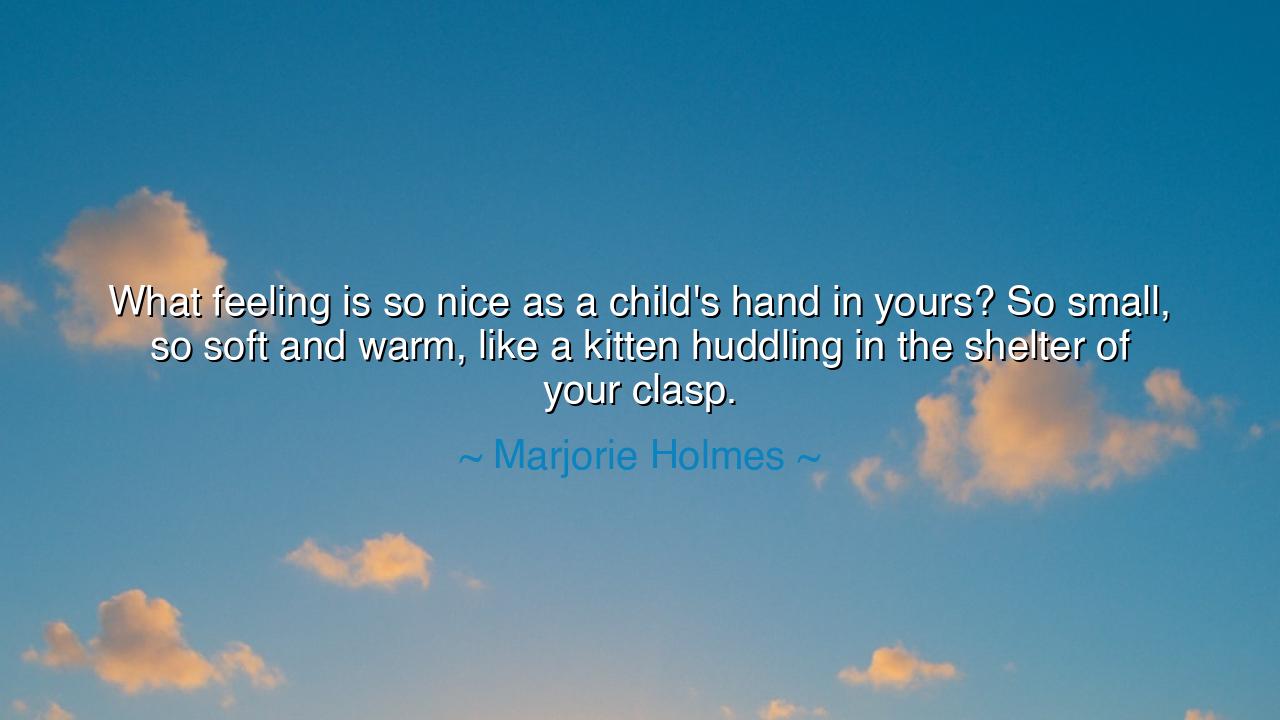
What feeling is so nice as a child's hand in yours? So small, so
What feeling is so nice as a child's hand in yours? So small, so soft and warm, like a kitten huddling in the shelter of your clasp.






In the words of Marjorie Holmes: “What feeling is so nice as a child’s hand in yours? So small, so soft and warm, like a kitten huddling in the shelter of your clasp.” This tender image speaks to the timeless bond between parent and child, guardian and innocent. The hand of a child is not merely flesh and bone—it is trust made visible, dependence made tangible, and love offered freely without hesitation. To hold such a hand is to carry the weight of responsibility and the lightness of joy all at once.
The ancients understood the power of touch as a sacred act. To clasp another’s hand was to forge connection, to seal promises, to extend protection. In Homer’s epics, warriors joined hands before parting for battle, fathers reached for their children before long journeys, and lovers clasped hands as pledges of fidelity. Yet the child’s hand carries something even greater—it is a hand that does not demand but trusts, that does not calculate but believes, that seeks only shelter in the embrace of another.
History gives us many images of this truth. Consider the story of Mahatma Gandhi, who often walked with children among his followers. The sight of their small hands in his became a symbol of the gentleness behind his strength. Though he carried the burdens of a nation, he still found time to guide a little one across a path. The warmth of those moments reflected a larger truth: that the strength of any leader, any parent, any guardian, is proven not in conquest, but in the way they treat the smallest and most vulnerable who trust them.
Holmes compares this feeling to a kitten huddling in safety. The metaphor is no accident. A kitten curls against its mother not only for warmth, but for survival, for reassurance that the world is not hostile but hospitable. So it is with the child who clasps your hand—they are saying without words, “You are my shelter. In your grasp, I am safe.” This trust is fragile, sacred, and must never be betrayed. To feel it is to be reminded of our highest calling: to protect innocence and nurture life.
The meaning of her words is both emotional and heroic. To clasp a child’s hand is to accept a role greater than oneself. It is to become a living fortress, a guardian of the tender, a guide to the unknowing. In that soft warmth lies the future, for every child who holds your hand today will walk into tomorrow with the lessons and the love you have placed within them.
The lesson is clear: never take lightly the moments when a child places their trust in you. These moments may seem small, but they echo for a lifetime. The warmth of the clasp is not only comfort for the child—it is transformation for the adult, teaching patience, tenderness, and humility. To hold a child’s hand is to be reminded that true strength lies not in domination, but in protection, not in pride, but in care.
Practical action flows from this wisdom: if you are a parent, guardian, or elder, slow your steps and let the child’s hand remain in yours as long as it seeks you. See in that gesture a sacred trust, and let your guidance be gentle, steady, and full of love. If you no longer walk with small children, still remember the principle—offer your figurative hand to those in need, the vulnerable, the uncertain, the weak. For every act of shelter given becomes a legacy that outlives you.
Thus, Marjorie Holmes’s words endure as a hymn to tenderness. The child’s hand, small and soft, is more than touch—it is the living emblem of trust. To clasp it is to enter into the noblest of duties: to guard, to guide, and to love without condition. And in this simple gesture, one discovers not only the beauty of childhood, but the very essence of humanity itself.






AAdministratorAdministrator
Welcome, honored guests. Please leave a comment, we will respond soon